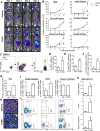AhR activation increases IL-2 production by alloreactive CD4+ T cells initiating the differentiation of mucosal-homing Tim3+ Lag3+ Tr1 cells
- PMID: 28833046
- PMCID: PMC5927372
- DOI: 10.1002/eji.201747121
AhR activation increases IL-2 production by alloreactive CD4+ T cells initiating the differentiation of mucosal-homing Tim3+ Lag3+ Tr1 cells
Abstract
Activation of the aryl hydrocarbon receptor (AhR) by immunosuppressive ligands promotes the development of regulatory T (Treg) cells. Although AhR-induced Foxp3+ Treg cells have been well studied, much less is known about the development and fate of AhR-induced Type 1 Treg (AhR-Tr1) cells. In the current study, we identified the unique transcriptional and functional changes in murine CD4+ T cells that accompany the differentiation of AhR-Tr1 cells during the CD4+ T-cell-dependent phase of an allospecific cytotoxic T lymphocyte (allo-CTL) response. AhR activation increased the expression of genes involved in T-cell activation, immune regulation and chemotaxis, as well as a global downregulation of genes involved in cell cycling. Increased IL-2 production was responsible for the early AhR-Tr1 activation phenotype previously characterized as CD25+ CTLA4+ GITR+ on day 2. The AhR-Tr1 phenotype was further defined by the coexpression of the immunoregulatory receptors Lag3 and Tim3 and non-overlapping expression of CCR4 and CCR9. Consistent with the increased expression of CCR9, real-time imaging showed enhanced migration of AhR-Tr1 cells to the lamina propria of the small intestine and colon. The discovery of mucosal imprinting of AhR-Tr1 cells provides an additional mechanism by which therapeutic AhR ligands can control immunopathology.
Keywords: AhR; CD4+ T cells; IL-2; Lag3; Migration; Tim3; Tr1 cells.
© 2017 WILEY-VCH Verlag GmbH & Co. KGaA, Weinheim.
Conflict of interest statement
Conflict of interest: The authors declare no commercial or financial conflict of interest.
Figures





Similar articles
-
2,3,7,8-Tetrachlorodibenzo-p-dioxin alters the differentiation of alloreactive CD8+ T cells toward a regulatory T cell phenotype by a mechanism that is dependent on aryl hydrocarbon receptor in CD4+ T cells.J Immunotoxicol. 2008 Jan;5(1):81-91. doi: 10.1080/15476910802019037. J Immunotoxicol. 2008. PMID: 18382861
-
Role of Aryl Hydrocarbon Receptor (AhR) in the Regulation of Immunity and Immunopathology During Trypanosoma cruzi Infection.Front Immunol. 2019 Mar 29;10:631. doi: 10.3389/fimmu.2019.00631. eCollection 2019. Front Immunol. 2019. PMID: 30984194 Free PMC article.
-
Tr1 Cells, but Not Foxp3+ Regulatory T Cells, Suppress NLRP3 Inflammasome Activation via an IL-10-Dependent Mechanism.J Immunol. 2015 Jul 15;195(2):488-97. doi: 10.4049/jimmunol.1403225. Epub 2015 Jun 8. J Immunol. 2015. PMID: 26056255
-
Type 1 regulatory T cells (Tr1) in autoimmunity.Semin Immunol. 2011 Jun;23(3):202-8. doi: 10.1016/j.smim.2011.07.005. Epub 2011 Aug 12. Semin Immunol. 2011. PMID: 21840222 Free PMC article. Review.
-
TH2 cells in the pathogenesis of airway remodeling: regulatory T cells a plausible panacea for asthma.Immunol Res. 2006;35(3):219-32. doi: 10.1385/IR:35:3:219. Immunol Res. 2006. PMID: 17172648 Review.
Cited by
-
The absence of AhR in CD4+ T cells in patients with acute graft-versus-host disease may be related to insufficient CTCF expression.Clin Epigenetics. 2022 Sep 2;14(1):109. doi: 10.1186/s13148-022-01330-7. Clin Epigenetics. 2022. PMID: 36056390 Free PMC article.
-
[DNAM-1 regulates the proliferation and function of T regulatory type 1 cells via the IL-2/STAT5 pathway].Nan Fang Yi Ke Da Xue Xue Bao. 2022 Sep 20;42(9):1288-1295. doi: 10.12122/j.issn.1673-4254.2022.09.03. Nan Fang Yi Ke Da Xue Xue Bao. 2022. PMID: 36210700 Free PMC article. Chinese.
-
Slc7a5 promotes T cell anti-tumor immunity through sustaining cytotoxic T lymphocyte effector function.Oncogene. 2025 Aug 26. doi: 10.1038/s41388-025-03543-5. Online ahead of print. Oncogene. 2025. PMID: 40858813
-
IL-2 regulates tumor-reactive CD8+ T cell exhaustion by activating the aryl hydrocarbon receptor.Nat Immunol. 2021 Mar;22(3):358-369. doi: 10.1038/s41590-020-00850-9. Epub 2021 Jan 11. Nat Immunol. 2021. PMID: 33432230
-
Gut Microbiota-Derived Tryptophan Metabolites Maintain Gut and Systemic Homeostasis.Cells. 2022 Jul 25;11(15):2296. doi: 10.3390/cells11152296. Cells. 2022. PMID: 35892593 Free PMC article. Review.
References
-
- Stockinger B, Di Meglio P, Gialitakis M, Duarte JH. The aryl hydrocarbon receptor: multitasking in the immune system. Annu Rev Immunol. 2014;32:403–432. - PubMed
-
- Frericks M, Meissner M, Esser C. Microarray analysis of the AHR system: tissue-specific flexibility in signal and target genes. Toxicol Appl Pharmacol. 2007;220:320–332. - PubMed
Publication types
MeSH terms
Substances
Grants and funding
LinkOut - more resources
Full Text Sources
Other Literature Sources
Research Materials

